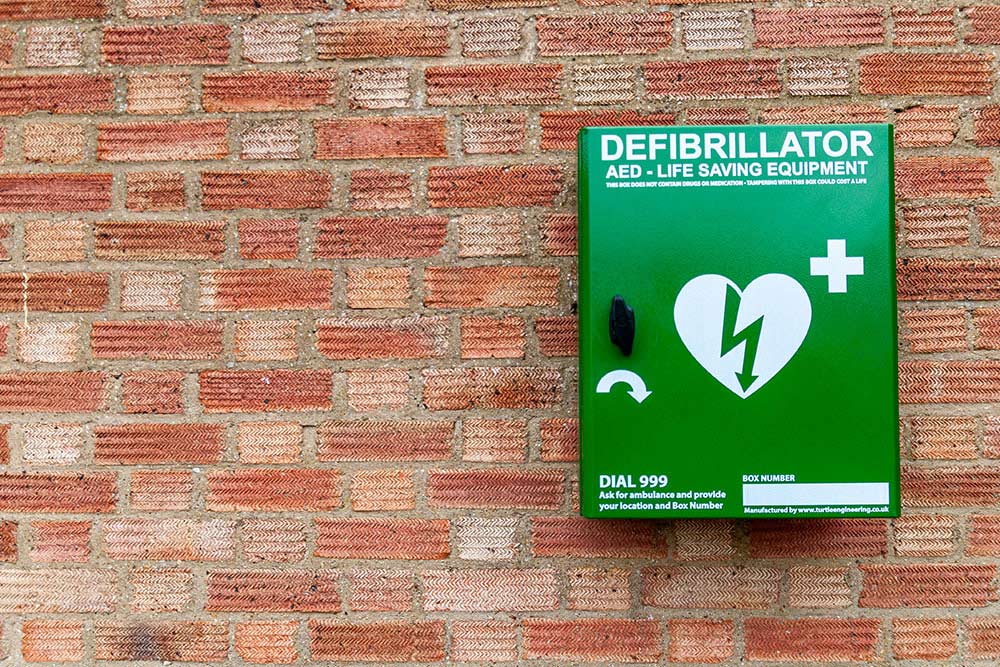
Your workplace probably has a first aid kit in case someone gets injured, right? But plasters and paracetamol aren’t going to cut it if someone’s heart stops. And someone’s heart could stop at any time. So, you need extra help. That’s where Automated External Defibrillators (AED) come in. They’re literally a lifesaver. Having defibrillators in the workplace is a no-brainer. Do you have one?
What is an AED?
An AED is a clever device that you attach to a person in cardiac arrest. It analyses their heart rhythm and gives their heart an electrical shock when necessary. If you want to know how to use an AED, check out this blog that will talk you through it.
When Do You Use an AED
When someone is unresponsive and not breathing, their heart has stopped. This is called cardiac arrest. And you only have a few moments to save them. To give them a fighting chance, first aiders are trained to do the following:
1 – Ensure 999 or 112 is called
2 – Administer cardiopulmonary resuscitation (CPR) right away
3 – Ask a helper to find and bring an AED
4 – Follow the instructions on the AED to use it
Regardless of whether or not you are trained in CPR, anyone can use an AED. This is why they are fundamental.
Understanding AEDs
There are two types of AED. Fully and Semi-Automatic. Fully automatic AEDs will administer the life-saving electrical shock automatically to the patient.
Semi-Automatic AEDs will prompt the bystander to push the ‘shock button’ to administer the electrical shock.
Either type of AED will come with visual and/or audio prompts that will show the user how to use the device. So, there’s no need to panic if you’re ever in that situation.
Components of an AED
How does it work? An AED is made up of:
- The processor, which analyses the patient’s heart to see if an electrical shock is needed
- Battery, which charges the capacitator so it has enough energy to perform the electrical shock
- Capacitator, which stores and releases the energy needed for the electrical shock
- Electrode pads are pads you will stick to the patient’s chest. If an electrical shock is needed to restart the heart, it will pass through these pads and deliver it
Now that you’re more familiar with an AED, hopefully, you won’t be intimidated by the device if you’re required to use it. This will allow you to act quicker.

Do You Need a Defibrillator?
‘I know CPR, do I really need a defibrillator?’ As we mentioned earlier, CPR is important when resuscitating someone with cardiac arrest. Both CPR and an AED can restart a heart. The idea is that you want everything at your disposal to increase your chances of saving the person’s life.
Increasing Chances of Survival
During cardiac arrest, the heart isn’t pumping blood around the body to essential things like the brain and lungs. CPR uses chest compressions to mimic how the heart pumps and keeps the blood flowing. An AED will jump-start the heart with an electric shock, sort of like a car battery.
So even though CPR does help, it should always work in conjunction with an AED to increase your chances of restarting the heart.
There are over 30,000 cardiac arrests that occur outside of hospitals each year in the UK. If an employee is unlucky enough to experience one, their chances of survival are around 10%. But, if an AED is used on them within the first minute of an arrest, the survival rate can jump up to as high as 90%. These results show that defibrillators in the workplace could be the difference between life and death for colleagues.
What the Law Says
The law does not strictly require all workplaces to have a defibrillator. However, it does require that you conduct a first aid needs assessment/risk assessment to determine if one is required. As the employer, you are required to carry out the risk assessment under the Health and Safety (first aid) Regulations 1981.
A First Aid Risk Assessment considers the circumstances of your workplace, and the hazards and risks present in it. They ask you to identify the hazards, evaluate the risk they present and put in place a suitable level of control for them. These controls will ensure that your workers are protected to a reasonably practicable level.
So, if your assessment determines it’s necessary, you should have AEDs on site.
Defibrillators for Schools
Work in a state-funded school? Well, the UK Government are committed to ensuring every school in the UK has at least one defibrillator. Their goal is to boost the number of defibrillators in communities. This has come after a young school boy tragically passed away after having a cardiac arrest during a school swimming lesson in 2011.
So, from 2023 onwards, all state-funded schools in the UK are required to have defibrillators. By comparison, in 2019 the British Heart Foundation found that only 15% of UK schools had a defibrillator. Considering how common cardiac arrests are, 2023 seems better late than never.
Life-Saving AED Defibrillator Training
Training will give you awareness of AEDs and how you should use them to try and save a life if the moment comes. Luckily, you can do this critical training with Human Focus.
Your employees’ lives are not something to gamble with. So, don’t. If saving them can be made simpler with training, take it. And, who knows, one day it could be your life that needs saving.


















































































































































































































































































































































































































































































































































































































































































































































